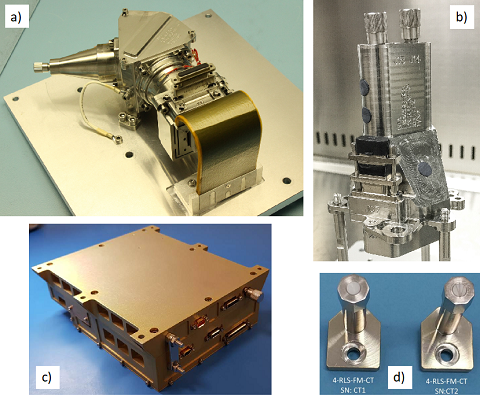The Raman Spectrometer for the ExoMars-ESA 2022 Mission to Mars
- 1Valladolid, Faculty of Sciences, Crystallography and Mineralogy, Spain (rull@fmc.uva.es)
- 2Unidad Asociada UVa-CSIC-CAB. Av. Francisco Valles 8. 47151. Boecillo (Valladolid), SPAIN
- 3INTA, Crtra. Ajalvir Km. 4. Torrejón de Ardoz (Madrid), SPAIN
- 4ISDEFE, Crtra. Ajalvir Km. 4. Torrejón de Ardoz (Madrid), SPAIN
Introduction
The Raman Laser Spectrometer (RLS) [1] is part of the analytical instrumental suite (Pasteur Payload) located inside the Analytical Laboratory Drawer (ALD) of the Rosalind Franklin rover for the ExoMars 2022 mission to Mars. RLS is based on the inelastic scattering of the matter when illuminated by a monochromatic light. This emitting radiation contains physicochemical information of the observed material through the vibrations of its atomic components. It this way RLS will contribute to the ExoMars scientific mission objectives identifying minerals and organic compounds at the mineral grain scale. And with this information supporting the key astrobiological questions the mission will address analyzing samples on the Martian surface and subsurface.
The instrument consists in four main units which are depicted in Figure 1 and its development and delivered models are described in references [1–5].
In this work interest is mainly devoted to the analysis of the scientific performances of the flight model (FM) currently integrated in the Rosalind Franklin rover, comparing it with the performances of the flight spare (FS) located at INTA in Madrid. This comparison is part of the general plan to characterize both instruments to better understand the FM behavior in support to the future operation in Mars. This plan also includes the correlation of the FS scientific outcome and the RLS ExoMars Simulator, a laboratory setup located in Valladolid University [6] emulating the RLS acquisition algorithms [7], as well as the sample preparation and distribution system (SPDS) positioning of the samples.

Figure 1. RLS instrument units. a) The SPU is the Spectrometer Unit, with a theoretical spectral resolution of 6-8 cm-1 [5]. b) The internal Optical Head (iOH) features an autofocus system, with 50 microns collection and excitation fibers [2,8]. c) The ICEU is the control electronics unit, also integrating the redundant 532 nm excitation laser [9]. d) The Calibration Targets will allow the calibration of the instrument, as well as the spatial correlation of the field-of-views of the different instruments of the Rosalind Franklin Analytical Laboratory Drawer [3].
Experimental
The instrument performances were evaluated after an appropriate calibration procedure that included observation of Ne and Ar-Hg emission lines to obtain the correlation function between pixels and correct wavelengths and the Raman observation of standard samples and the PET calibration target to obtain the right wavenumber positions.
After that a campaign with selected samples of very different Raman molar efficiency was undertaken. In the FM case this campaign comprised the pre-delivery experiments with a limited set of samples, given the extremely tight delivery schedule for the flight instrument to ESA. Once after integration, only the Calibration Target material (PET) can be used for health or any other checks, as no samples will be introduced into the sealed ultra-clean zone of the analytical laboratory drawer (ALD) of the rover until arrival to Mars.
However, the development of the RLS FS (identical in every sense to the FM), has provided a unique opportunity to perform thorough scientific analysis that will be used to properly characterize and parameterize the flight instrument. These experiments will be correlated with heavy duty analysis performed by the RLS ExoMars Simulator, which is designed to work in a laboratory environment, thus allowing the analysis of samples without the operational constraints of the RLS FS.
Several samples relevant to Mars have been analyzed at the present. These samples are collected from the ADAMM database, a collection of materials representative of different Martian locations and specifically the landing sites of ExoMars 2022 (Oxia Planum) and Mars 2020 (Jezero Crater) missions, which is presented in this conference. In addition, synthetic mixtures of materials used to perform calibration curves for the quantification of mineral abundances from RLS data (publication in press), or other representative materials to optimize the acquisition parameters of the instrument are analyzed (a dedicated presentation is presented in this conference).
Results and discussion
In this conference we will present and discuss the evolution of Raman spectra of the CT acquired with the RLS FM instrument, to verify the evolution of the instrument throughout all the steps from the pre-delivery stage, including the spectra obtained in relevant environments during the Assembly, Integration and Test (AIT) phases of the ALD and rover integration process. And also, the results regarding the correlation of the FS instrument and the RLS ExoMars Simulator data to the RLS FM instrument. These results will be key for defining the instrument capabilities and expected scientific performance of the instrument once on Mars.
Acknowledgements
MINECO grants ESP2014-56138-C3-1-R, ESP2014-56138-C3-2-R, ESP2107-87690-C3-1-R, ESP2107-87690-C3-3-R.
References
[1] F. Rull et al., et al. Astrobiology. 17 (2017) 627–654. https://doi.org/10.1089/ast.2016.1567.
[2] A. Santiago et al. Proc. SPIE - Int. Soc. Opt. Eng., 2018. https://doi.org/10.1117/12.2313462.
[3] G. Lopez‐Reyes et al. J. Raman Spectrosc. (2020) jrs.5832. https://doi.org/10.1002/jrs.5832.
[4] A.G. Moral et al. J. Raman Spectrosc. (2019) jrs.5711. https://doi.org/10.1002/jrs.5711.
[5] J.F. Cabrero et al. In: Proc. SPIE 11180 (2019) 115. https://doi.org/10.1117/12.2536035.
[6] G. Lopez-Reyes et al. Eur. J. Mineral. 25 (2013) 721–733. https://doi.org/10.1127/0935-1221/2013/0025-2317.
[7] G. Lopez-Reyes, F. Rull Pérez, J. Raman Spectrosc. 48 (2017) 1654–1664. https://doi.org/10.1002/jrs.5185.
[8] G. Ramos et al. In: Proc. SPIE - Int. Soc. Opt. Eng., (2017). https://doi.org/10.1117/12.2277003.
[9] P. Ribes-Pleguezuelo et al. Proc SPIE - Opt. Eng. 55(11), 116107 (2016), https://doi: 10.1117/1.OE.55.11.116107
How to cite: Rull, F., Moral, A., Lopez-Reyes, G., Perez, C., Rodriguez, J. A., Rodriguez, P., Veneranda, M., Manrique, J. A., saiz, J., Sanz, A., and Medina, J.: The Raman Spectrometer for the ExoMars-ESA 2022 Mission to Mars, Europlanet Science Congress 2020, online, 21 Sep–9 Oct 2020, EPSC2020-1037, https://doi.org/10.5194/epsc2020-1037, 2020.

